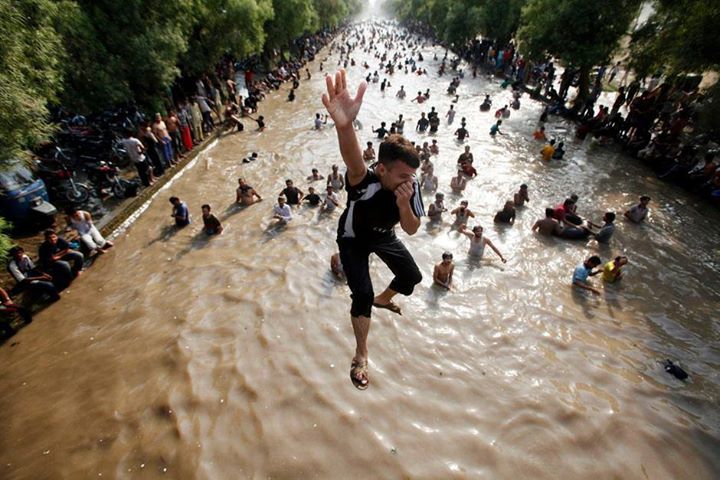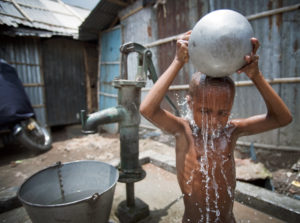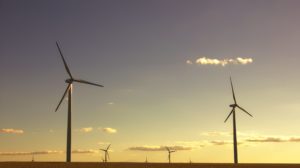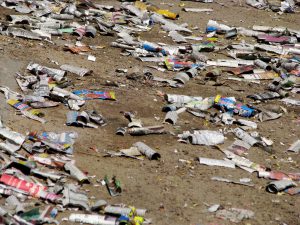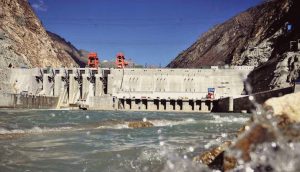When the mercury shoots up, when the skies turn dark with the promise of rain, when the winter sets in and the warm sunlight beckons… Lahore’s famed canal and the green belt that runs alongside it is the go to place in all seasons for people in Pakistan’s second largest city. Over the years, however, the 60-kilometre waterway has earned the sobriquet ‘killer canal’ with accidental deaths and contamination due to untreated domestic and industrial effluents turning its waters unsafe for swimming, irrigation and livestock consumption.
The canal has been an integral part of life in the city, the one image associated with it being swarms of people, both in swimming garb and fully clothed, jumping into the waters flanked by a thick foliage of trees on hot summer days. The more people in the canal, the higher the temperature, it is believed. In the last couple of years, however, it has also been in the news for several deaths caused by drowning or injuries.
The waters have turned increasingly toxic, not just for people who frolic in its waters and brave skin diseases but also livestock and agriculture that are sustained by it. Studies and laboratory tests on the canal water by the environmental department have discovered excessive levels of pollutants and chemicals from untreated waste thrown into the canal.
Lahore lifeline
About half of the 60 kilometres of the Lahore Branch Canal runs through the heart of the city, the capital of Punjab state. Emanating from the Bambawali-Ravi-Bedian Canal on the eastern side of the city towards the Indian border, this branch canal is used for irrigation purposes as well as recreation.
After passing through the city, this distributary channel serves 400,000 acres of fertile agriculture land in its vicinity and the neighbouring district of Kasur.
The canal, with an average depth of five feet, was obviously not built for swimming or diving but people have over the years been using it to cool off – the unsuspecting don’t know about sewerage pipes and other solid structures at certain points of the canal leading to the accidents, say residents.
For decades, untreated domestic and industrial wastewater has poured into the Lahore Branch Canal, overflowing from gutters and drainpipes coming from the dozens of unapproved housing societies and shops that have come up along its length.
Many housing societies, set up on both sides of the canal in the eastern part of the city, have no drainage systems at all, said Mian Farooq Kashif, president of Al-Hamd Welfare Foundation in the city’s Tajpura locality that is also situated along the water channel.
Kashif, a retired banker, blames civic authorities for the mess. “They allowed these housing societies to develop without providing proper drainage system, and now all the waste is flowing into the canal. You can see drainage pipes throwing wastewater directly into the canal.”
Apart from municipal waste, industrial effluents from workshops and small factories on this route are also finding their way to the canal, said Kashif.
Polluted waters
Studies show pollution worsens in the Lahore section of the canal. According to a study titled ‘Determination Of Pollutants In Water Of Bambawala-Ravie-Badian Canal And Lahore Branch Canal’ published by the Journal of Pakistan Institute of Chemical Engineers, the biochemical oxygen demand (BOD) and chemical oxygen demand (COD) values increase when the water enters Lahore and do not meet National Environmental Quality Standards (low levels are a sign of healthy water bodies).
People swimming in the waters can be infected by harmful pathogenic bacteria and may suffer skin diseases, said Najam-uz-Zaman Nanji, spokesperson of the Punjab irrigation department. This water is also harmful for cattle that drink it even when it reaches agricultural fields beyond city limits.
Analysis from Punjab’s Environment Protection Department bears this out. Levels of pollutants are dangerously high, reveals the report that covers various localities in the city. EPD Director General Javed Iqbal told thethirdpole.net that these values were tested against national surface water standards.
* According to the report, for instance, pH level at the Harbanspura Mor locality was 12.1, against the desirable limit of 6-9 for surface water.
* Total Dissolved Solids level was 7740 mg/l (milligrams per litre) at Harbanspura against the desirable limit of 3500 mg/l.
* Total Suspended Solids level was 980 mg/l at the spot against the desirable limit of 200 mg/l.
* Chemical oxygen demand (COD) was 5,200 mg/l near Omer Hayat Carpet Unit near Harbanspura against desirable limit of 150.
* Sulphate level was 2,196 mg/l at Omer Hayat Carpet Unit near Harbanspura against desirable limit of 600 mg/l.
* Biochemical oxygen demand (BOD) level was 885 mg/l at Gulistan Colony against desirable limit of 80 mg/l.
*Sulphide limit was 60 mg/l at Pull Lubna stop against the desirable limit of 1 mg/l.
*Oil and grease level was 700 mg/l at Tuls Pura against the desirable limit 10 mg/l.
Explaining, Iqbal said the water high was turbid and rich in bacteria and drinking it may cause hepatitis and other viral diseases. Skin diseases and ear, nose and throat infections are also a possibility. Chemical oxygen demand levels were high due to contamination caused by pollutants that do not naturally decompose. Similarly, he said, sulphide and sulphate concentration was due to detergents being drained into the water. There are many places along the Lahore canal where high levels of faecal coliform bacteria have been found.
Government moves
The Punjab government stepped in this year with a Rs.332 million (US$3.3 million) plan to remove sewer inlets from the canal, lay parallel sewer lines on both sides and connect them to a new sewerage system. The task has been given to the Water and Sanitation Agency (WASA), which has already floated tenders. Once the system is in place, effluents will be disposed of without becoming part of the canal water, it is hoped.
What is more important, many believe, is that these should be followed up and not abandoned half-way.
The project of laying a new sewerage system was first discussed in 2012 when the estimated cost was Rs.200 million (US$2 million), said lawyer and environmental activist Rafay Alam, who has taken up the issue of contamination of natural water bodies in court. Even now, the money has only been allocated and there is no assurance that the project will be initiated and completed this year, he stressed, adding that it was still not clear whether the effluents would be thrown in the Ravi River after treatment or before.
WASA spokesperson Imtiaz Ghauri dispelled his fears and said things were moving in the right direction. “We have blocked most of the drainage pipes throwing effluents into the canal. Now they are directing it to parallel channels built to provide a temporary solution,” he explained.
Legal recourse
Polluting canal water is a violation of different laws and is punishable as well, said renowned environmental lawyer Sardar Asif Ali Sial. He told the thethirdpole.net that the Pakistan Environmental Protection Act 1997 strictly prohibits discharges or emissions which are in excess of national standards. The Canal and Drainage Act also prohibits discharge of effluents into canal and drainage works. Under this act, the provincial government may prohibit the discharge of any waste into rivers, canals and drainage channels.
Section 269 of the 1860 Pakistan Penal Code is also relevant in this particular case as it prescribes punishment for negligent acts likely to spread infection of diseases dangerous to life, Sial said.
